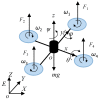Novel Fuzzy PID-Type Iterative Learning Control for Quadrotor UAV
- PMID: 30577657
- PMCID: PMC6339156
- DOI: 10.3390/s19010024
Novel Fuzzy PID-Type Iterative Learning Control for Quadrotor UAV
Abstract
Due to the under-actuated and strong coupling characteristics of quadrotor aircraft, traditional trajectory tracking methods have low control precision, and poor anti-interference ability. A novel fuzzy proportional-interactive-derivative (PID)-type iterative learning control (ILC) was designed for a quadrotor unmanned aerial vehicle (UAV). The control method combined PID-ILC control and fuzzy control, so it inherited the robustness to disturbances and system model uncertainties of the ILC control. A new control law based on the PID-ILC algorithm was introduced to solve the problem of chattering caused by an external disturbance in the ILC control alone. Fuzzy control was used to set the PID parameters of three learning gain matrices to restrain the influence of uncertain factors on the system and improve the control precision. The system stability with the new design was verified using Lyapunov stability theory. The Gazebo simulation showed that the proposed design method creates effective ILC controllers for quadrotor aircraft.
Keywords: fuzzy control; iterative learning control; proportional-interactive-derivative (PID); quadrotor unmanned aerial vehicle (UAV); trajectory tracking.
Conflict of interest statement
The authors declare no conflict of interest.
Figures








References
-
- Ryll M., Buelthoff H.H., Giordano P.R. A Novel Overactuated Quadrotor Unmanned Aerial Vehicle: Modeling, Control, and Experimental Validation. IEEE Trans. Control Syst. Technol. 2015;23:540–556. doi: 10.1109/TCST.2014.2330999. - DOI
-
- Park J., Kim Y., Kim S. Landing Site Searching and Selection Algorithm Development Using Vision System and Its Application to Quadrotor. IEEE Trans. Control Syst. Technol. 2015;23:488–503. doi: 10.1109/TCST.2014.2341214. - DOI
-
- Abdolhosseini M., Zhang Y.M., Rabbath C.A. An Efficient Model Predictive Control Scheme for an Unmanned Quadrotor Helicopter. J. Intell. Robot. Syst. Theory Appl. 2013;70:27–38. doi: 10.1007/s10846-012-9724-3. - DOI
-
- Alexis K., Nikolakopoulos G., Tzes A. On trajectory tracking model predictive control of an unmanned quadrotor helicopter subject to aerodynamic disturbances. Asian J. Control. 2014;16:209–224. doi: 10.1002/asjc.587. - DOI
Grants and funding
LinkOut - more resources
Full Text Sources

